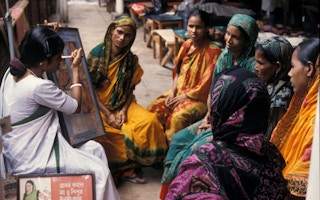We have a decade left to achieve the United Nations Sustainable Development Goals (SDGs), and we are nowhere near where we need to be to succeed.
One crucial reason is that women remain largely excluded from decision-making processes, which leads to policies that do not provide women the support they need to prosper — or even to survive. Nowhere is this dynamic more apparent than in the health sector.
Women comprise roughly 70 per cent of the global health workforce, and perform the majority of the sector’s most challenging, dangerous, and labor-intensive jobs. Yet they hold only 25 per cent of the health sector’s senior roles, and are rarely represented adequately in policymaking.
Instead, they are often expected to remain passive actors, quietly finding ways to do their jobs in difficult — even impossible — circumstances.
The reality for women health workers was reflected in a recent letter to the medical journal The Lancet from two Chinese nurses describing the conditions they and their colleagues face on the frontlines of the battle against the new coronavirus, COVID-19, at its source in Wuhan, China.
It may be an extreme case (and the letter has now been retracted over claims that it was not a firsthand account), but the challenges described, from shortages of protective equipment to chronic overwork and exhaustion, are all too familiar to health workers everywhere.
Such conditions make essential health-sector jobs unattractive, contributing to severe labor shortages worldwide. The World Health Organisation estimates that, for all countries to achieve SDG 3 (“ensure healthy lives and promote well-being for all at all ages”), an additional nine million nurses and midwives will be needed globally by the year 2030.
Closing this gap is a matter of life and death. For example, midwives are often the difference between safe childbirth and newborn or maternal mortality. Lack of access to them — especially for vulnerable populations, such as poor rural dwellers — is a major reason why two-thirds of all maternal deaths occur in Sub-Saharan Africa.
The WHO estimates that adequate midwifery care (including family planning) could prevent 83 per cent of all maternal deaths, stillbirths, and newborn deaths.
“
Lack of access to them — especially for vulnerable populations, such as poor rural dwellers — is a major reason why two-thirds of all maternal deaths occur in Sub-Saharan Africa.
Infant and maternal mortality are hardly limited to developing countries. In the United States, the maternal mortality rate has actually increased in recent decades, from 7.2 deaths per 100,000 live births in 1987 to 16.9 deaths per 100,000 live births in 2016.
More than half of these deaths could have been prevented if the mothers had better understood the importance of — and had easier access to — quality prenatal and postpartum care.
There is a clear racial dimension to this disturbing trend. In the US, a black woman is 3-4 times more likely than a white woman to die from complications in pregnancy. In the United Kingdom, that multiple rises to five.
While this discrepancy may be partly explained by health complications black women experience, racial bias also plays a role. Black women often report feeling that they are not taken seriously by medical professionals.
The health consequences of not listening to women extend further. Children born to healthy mothers are more likely to remain healthier throughout their lives. Because a woman is most likely to engage with the health sector during pregnancy, the support of a midwife or nurse can pull a woman’s entire family into the health-care system.
In a bid to recognize their vital contribution in the health sector, the WHO has designated 2020 as the Year of the Nurse and the Midwife. But beyond celebrating nurses and midwives for their hard work, we must seek to rectify structural inequities that exclude women from leadership positions in these professions.
That is a key goal of the upcoming Women in Dev conference — a women-led, women-focused initiative that deserves the support of us all.
From labor shortages to racial bias, the barriers to achieving SDG 3 are as diverse as they are high. But the chances of success are significantly better if we listen to those who understand the situation on the ground, and work to enhance inclusion at all levels, taking into account varying socioeconomic conditions.
This will require a fundamental shift in mindset, with publics and policymakers alike recognising that women — as nurses, midwives, and mothers — are often the gatekeepers of health.
A decade of rapid progress toward SDG 3 is possible. But women must be at the helm.
Toyin Saraki is the Founder and President of The Wellbeing Foundation Africa.
Copyright: Project Syndicate, 2020.
www.project-syndicate.org


















